SUBJECTS
GRADE
Show Results
Blast Off
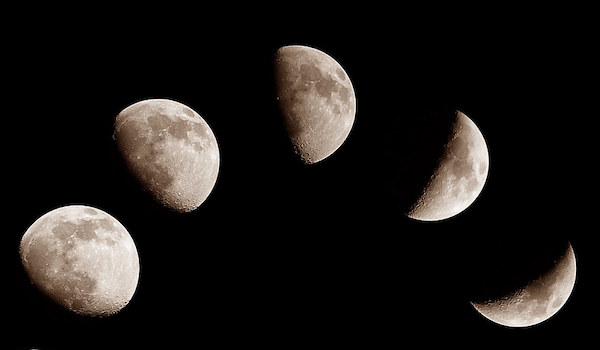
Lesson Summary
- Perform dances that reflect the phases and rotation of the moon.
Lesson Plan and Procedure
Lesson Key Facts
- Grade(s): 6
- Subject(s): Dance, Science
- Duration of lesson: 40 minutes
- Author(s): Jana Shumway
Experience/Identify
Have the children spread out in the room, facing the same direction, and create shapes in response to the words called out.
Note: It may help as you demonstrate to face away from them, so they can easily tell the left and right sides.
| Moon Phases | Shape |
|---|---|
| Full moon | Make a huge, outstretched shape with the whole body. |
| Waning gibbous | Let half of the left side of the previous shape melt in a little. |
| Third quarter | Reach the right half of the body out and have the left half create a straight line. |
| New moon | Fall down and make a low, flat shape with closed eyes. |
| Waxing crescent | Curve the body to the left like a banana |
| First quarter | Reach the left half of the body out and have the right half create a straight line. |
| Waxing gibbous | Make a bigger shape until the body is filled out except for a slightly melted right side. |
| Full moon | Make a huge, outstretched shape with the whole body. |
Have the children gather in a group in front of you and repeat the shapes just created as they go around you. Note: you will face the same the direction the whole time.
Repeat the activity and have the students move around you, simulating how the moon travels around the earth, in 28 seconds (to represent the 27.32 days it takes the moon to travel around the earth). At the count of 14, the children should be at the new moon position behind you.
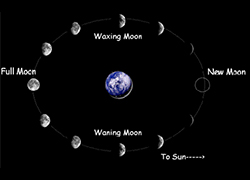
Explore/Investigate
Play the song “España” by Patrick O'Hearn in the background. Repeat as necessary.
Turn the lights off and turn on the spotlight, creating a nighttime feel.
Gather on one side of the room and step into your rocket ships. Crouch down with your arms above your head in a rocket shape and count down.
Teacher: Ten . . . nine . . . eight . . . seven . . . six . . . five . . . four . . . three . . . two . . .one . . . blast off!
Run in curving pathways around the room. After a little while, “notice” a moon and gently land on its surface, crouching in a landing shape.
Teacher: Make sure your mask is on tight because there is no oxygen on the moon.
Have the children walk on the moon slowly and lightly. Encourage them to let their arms and legs float and lift. Name this the moonwalk. You will use it to travel to different locations on the moon.
Activity 1: Lunar Highlands
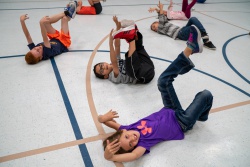
Travel to the lunar highlands with the moonwalk. (You could make this an actual location in the room or a location that is individually chosen by each student.)
Have the children lie on their backs and stick their arms and legs in the air in crooked, jagged shapes.
Teacher: The lunar highlands are the heavily cratered areas on the moon. When we look at the moon, the lunar highlands are the lighter color.
Show several images of the lunar highlands.
Activity 2: Maria

Travel to the maria with the moonwalk.
Have the children lie on their stomachs and reach out in all directions as flat and smooth as possible.
Teacher: The maria are the “seas” of the moon, but since there is no water on the moon, they are filled with cooled lava. When we look at the moon, the maria are the darker spots.
Show images of the maria.
Activity 3: South Pole-Aitken Basin
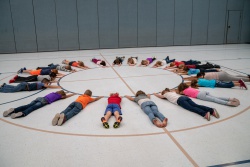
Travel to the South Pole-Aitken basin with the moonwalk.
Have half the children gather in a circle and hold still in jagged shapes (like the edges of a crater). Have the other half lift up their arms high and then dive down into the center of the circle onto the ground and lie flat.
Teacher: The South Pole-Aitken basin is a huge impact crater on the far side of the moon. It is approximately 1,600 miles in diameter and eight miles deep. It is one of the largest-known impact craters in the solar system and is the largest, oldest, and deepest basin on the moon.
Show images of the South Pole-Aitken basin.
Activity 4: Regolith
2-resize.jpg)
Travel to the regolith with the moonwalk.
Have the children do light leaps and jumps with light floating arms and legs.
Teacher: Regolith is “moon dust,” or a layer of dust and fragmented, pulverized rock that covers the surface of the moon.
Show images of the regolith.
Activity 5: Mare Orientale
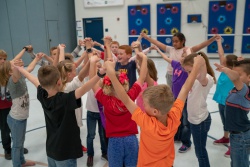
Travel to the Mare Orientale with the moonwalk.
Have two children hold hands in a circle in the center of the room. Have five to six students create a circle around them. Have the remainder of the students make a ring around the five to six. Once everyone is there, have them create jagged shapes.
Teacher: The Mare Orientale is a multi-ringed basin caused by huge impacts that created mountain ranges from shockwaves.
Show images of the Mare Orientale.
Activity 6: Life
Ask the children if there is life on the moon. (Answer: No.)
Have the students collapse on the ground and lie there lifeless.
Call out the above places of the moon without physically demonstrating them for the children. Assess the children’s knowledge, seeing if they can respond with the correct movement. Mix up the order.
Create/Perform

Note: There are many variations on how to perform for each other.
Here are a few ideas:
- Allow part of the class to do one feature of the moon and have the other part of the class watch, and then switch back and forth.
- Split the class into groups. Assign each group a part of the moon to perform. Have the children perform and watch other groups perform their respective features.
Connect/Analyze
Teacher: It’s time to go home!
Have everyone climb back inside their rockets and put their arms up in a point. Count down together from 10. Run for a while in curving pathways and land back down by the side of the room that you began at.
Show pictures of the moon: the lunar highlands, maria, South Pole-Aitken basin, regolith, and the Mare Orientale. Review the interesting facts about these features and make the connection between the picture and the movement performed.
Learning Objectives
- Describe the physical features of the moon.
- Describe the phases of the moon.
- Describe the movement of the moon as it appears from earth.
- Remember the movements associated with the different phases of the moon and the different parts of the moon.
- Make shapes with similar characteristics to that of the moon.
Utah State Board of Education Standards
This lesson can be used to meet standards in many grades and subject areas. We will highlight one grade’s standards to give an example of application.
Grade 6 Science with Engineering Education (SEEd)
- Standard 6.1.1: Develop and use a model of the Sun-Earth-Moon system to describe the cyclic patterns of lunar phases, eclipses of the Sun and Moon, and seasons. Examples of models could be physical, graphical, or conceptual. (ESS1.A, ESS1.B)
Grade 6 Dance
- Standard 6.D.CR.2: Use a variety of stimuli and solve multiple movement problems to develop unique choreographic content.
- Standard 6.D.P.2: Integrate original still and moving shapes and floor and air pathways into dance sequences.
Equipment and Materials Needed
- Music track: “España” by Patrick O’Hearn
- Spotlight
- Visuals of the moon:
- Lunar highlands
- Maria
- South Pole-Aitken basin
- Regolith
- Mare Orientale
Additional Resources
- https://en.wikipedia.org/wiki/Moon
- http://science.howstuffworks.com/moon1.htm
- http://www.astrosociety.org/edu/publications/tnl/12/12.html
Image References
Image 1: "Phases of the Moon" by SivamDesign is licensed under CC BY-NC 2.0
Image 2: ScienceBlogs (http://scienceblogs.com/startswithabang/files/2011/06/moon-cycles.gif).
Images 3–8: BYU Arts Bridge Student Blogs (http://education.byu.edu/arts/bridge/2016).

www.education.byu.edu/arts/lessons
 Download
Download